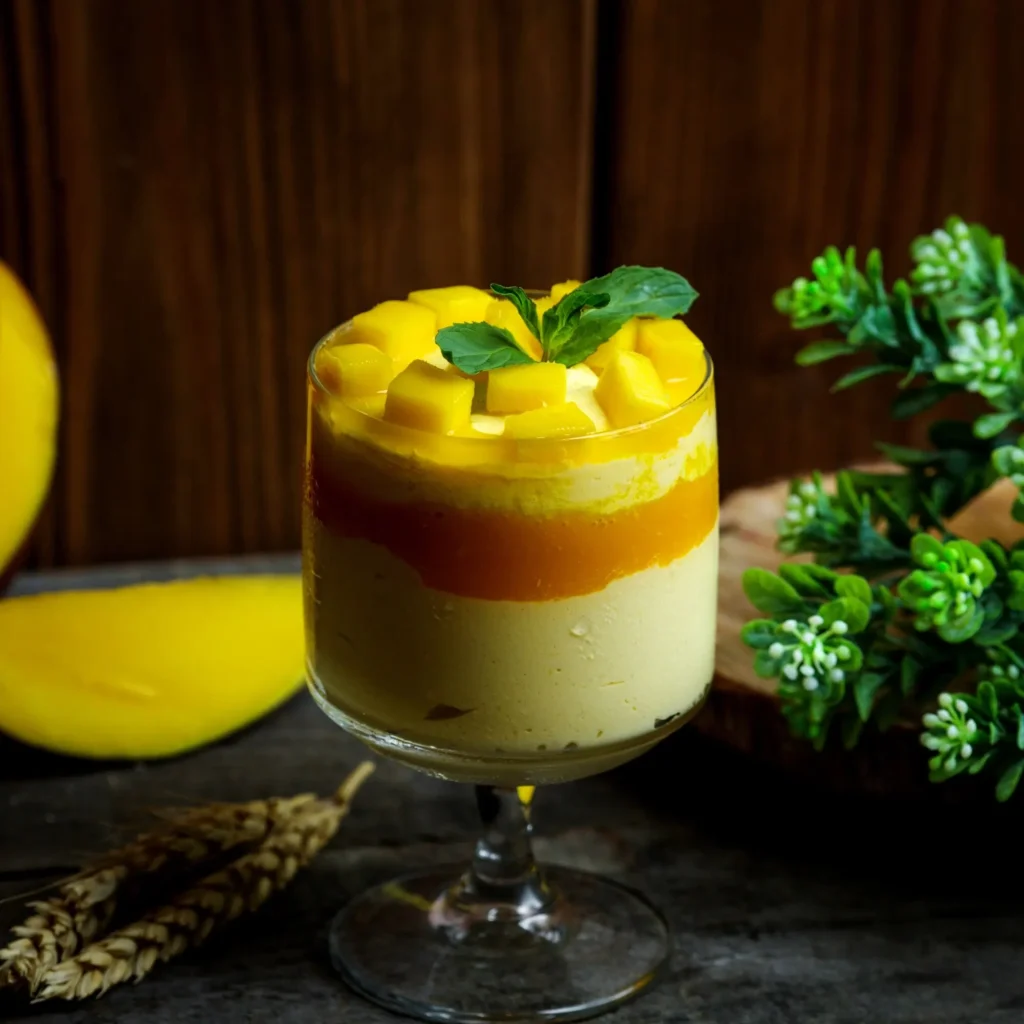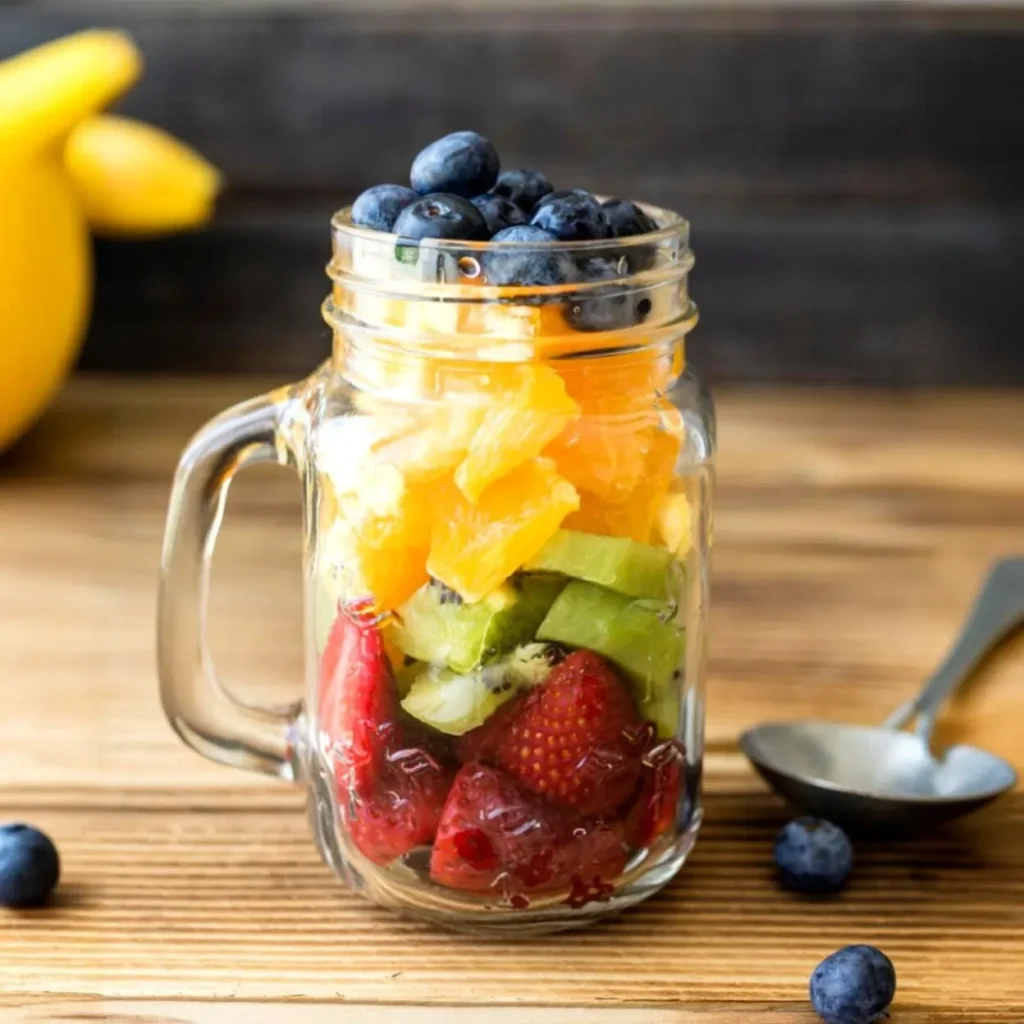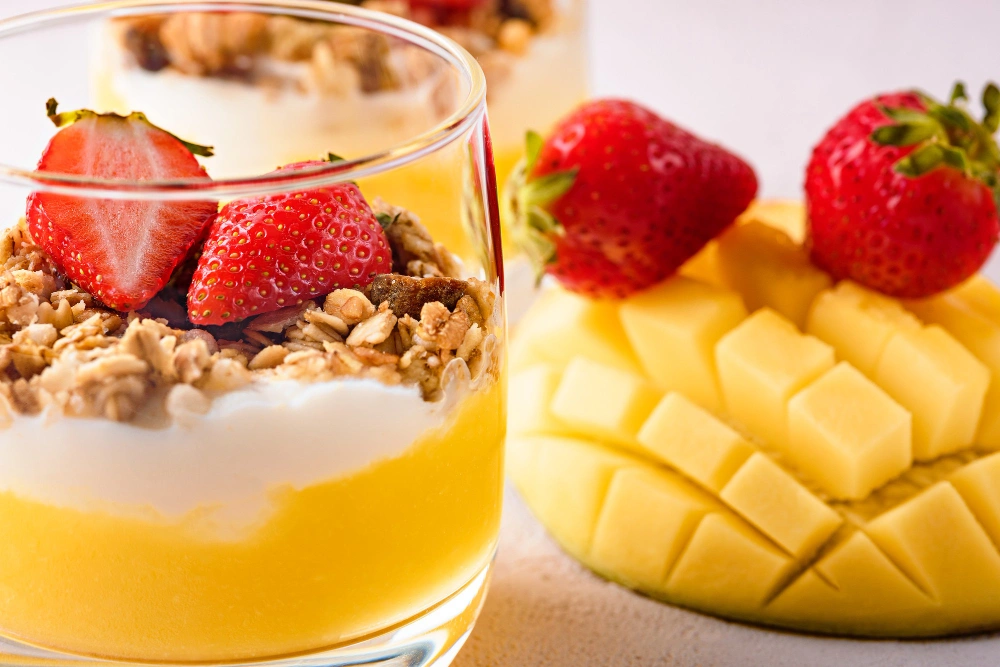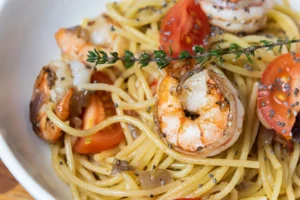Introduction to Smoothie mit Mango
“Smoothie mit Mango” is a delicious and refreshing mango smoothie, a popular drink made from blended mangoes and other ingredients like yogurt, milk, or juice. This smoothie is known for its naturally sweet taste, creamy texture, and tropical flavor.
Mango smoothies are not only tasty but also packed with nutrients. Mangoes are rich in vitamins A and C, fiber, and antioxidants, making them a great choice for a healthy diet. They help boost immunity, improve digestion, and promote glowing skin.
You can customize a mango smoothie by adding different ingredients such as bananas, berries, coconut milk, or protein powder to enhance its flavor and nutritional value. It is a perfect drink for breakfast, a post-workout snack, or a refreshing summer treat.
For a deeper dive into crafting this tropical delight, check out our comprehensive smoothie mit mango guide.

Essential Ingredients for Smoothie mit Mango
When crafting a delicious smoothie mit mango, selecting the right ingredients is crucial. A basic mango smoothie typically includes the following components:
- Mango: Fresh or frozen mango chunks serve as the star ingredient.
- Liquid: Options like coconut water, almond milk, or yogurt can be used.
- Sweetener: Honey or agave syrup can enhance the sweetness, depending on your preference.
- Additional Fruits: Bananas or pineapples can be added for extra flavor and texture.
- Vegetables: Spinach or kale can boost the nutritional value without overpowering the taste.
By choosing high-quality ingredients, you ensure that your smoothie mit mango is not only delicious but also nutritious.
By combining these ingredients, you ensure a smoothie that is both delicious and packed with health benefits. For more tips, explore our step-by-step mango smoothie recipe.
Step-by-Step Recipe for Smoothie mit Mango
Creating a smoothie mit mango at home is a straightforward process. Follow these simple steps for a creamy, flavorful drink:
- Gather your ingredients: Start with 1 cup of fresh or frozen mango chunks, 1 cup of liquid (like almond milk), and any additional fruits or vegetables you desire.
- Blend: Combine all ingredients in a blender. Start with liquids first to allow for smooth blending.
- Adjust sweetness: Taste the mixture and add a sweetener if needed. Blend again until smooth.
- Serve: Pour the smoothie into a glass and enjoy immediately for the best flavor and texture.
With this step-by-step guide, making a smoothie mit mango becomes an enjoyable and rewarding experience.

Health Benefits of Mango Smoothies
Mango smoothies are not only delicious but also packed with essential nutrients that offer several health benefits. Here are some key advantages of consuming mango smoothies:
Rich in Vitamins and Minerals
Mangoes are an excellent source of vitamin C, vitamin A, and vitamin E, which help boost immunity, improve skin health, and support vision.
Supports Digestion
Mangoes contain dietary fiber and enzymes like amylases, which aid in digestion and prevent constipation.
Boosts Immunity
The high vitamin C content in mango smoothies strengthens the immune system and helps the body fight off infections.
Promotes Healthy Skin and Hair
Mangoes are rich in antioxidants and vitamin A, which contribute to glowing skin and stronger hair.
Provides Natural Energy
The natural sugars in mangoes provide a quick energy boost, making mango smoothies a great pre- or post-workout drink.
Supports Heart Health
Mangoes contain potassium and fiber, which help regulate blood pressure and support cardiovascular health.
Aids in Weight Management
When made with healthy ingredients like yogurt, almond milk, or protein powder, mango smoothies can be a satisfying and nutritious meal replacement for weight management.
Hydrates the Body
Mangoes have high water content, and when blended into a smoothie, they help keep the body hydrated, especially during hot weather.
Reduces Inflammation
Mangoes contain polyphenols and beta-carotene, which have anti-inflammatory properties that may help reduce the risk of chronic diseases.
Supports Eye Health
With high levels of vitamin A and beta-carotene, mango smoothies contribute to better vision and reduce the risk of eye-related disorders.
Mango smoothies are a tasty and nutritious way to enjoy the numerous health benefits of mangoes. By blending them with ingredients like yogurt, nuts, or seeds, you can create a well-balanced drink that supports overall health and well-being.
Enjoy your mango smoothie as a refreshing and wholesome treat!
Creative Variations of Smoothie mit Mango
While the classic smoothie mit mango is delicious on its own, there are numerous creative variations to try. Here are some ideas to inspire your next blend:
- Tropical Twist: Add coconut milk and pineapple for a tropical flair.
- Green Mango Smoothie: Include spinach or kale for a nutrient boost without altering the flavor significantly.
- Spicy Mango Smoothie: A pinch of cayenne pepper or ginger can introduce a spicy kick.
- Berry Blast: Blend in mixed berries for a burst of color and flavor.
These variations allow you to personalize your smoothie mit mango, catering to your taste preferences while keeping it interesting.
Tips for Serving and Enjoying
To fully appreciate your smoothie mit mango, consider these serving tips:
- Chill Your Ingredients: Use frozen mango or chill the liquid to enhance the smoothie’s refreshing qualities.
- Garnish: Top with fresh mango slices, chia seeds, or mint leaves for an appealing presentation.
- Pairings: Enjoy your smoothie alongside a light snack, such as whole-grain toast or yogurt, for a balanced meal.
- Storage: If you have leftovers, store them in an airtight container in the refrigerator for up to 24 hours. Shake well before consuming.
By incorporating these tips, you can elevate your enjoyment of smoothie mit mango, making it a delightful part of your day.
Common Mistakes to Avoid
When preparing a smoothie mit mango, certain pitfalls can detract from the final product. Here are some common mistakes to avoid:
- Overloading Ingredients: Adding too many fruits or liquids can result in an unbalanced flavor and texture.
- Not Blending Long Enough: Failing to blend sufficiently can leave you with a chunky smoothie rather than a smooth consistency.
- Using Ripe Mango: Ensure your mango is ripe for optimal sweetness and flavor; under-ripe fruit can lead to a less enjoyable smoothie.
- Skipping the Liquid: Neglecting to add a liquid component can make your smoothie overly thick and difficult to drink.
By steering clear of these mistakes, your smoothie mit mango will be a delightful and satisfying treat.
FAQ’s
What fruit blends well with mango?
Mango pairs wonderfully with a variety of fruits, enhancing both flavor and texture in smoothies. Some excellent options include:
- Pineapple: Adds a tropical twist and a sweet-tart flavor.
- Banana: Provides creaminess and natural sweetness.
- Berries: Strawberries, blueberries, and raspberries complement mango beautifully, adding color and antioxidants.
- Coconut: Fresh coconut or coconut milk enhances the tropical profile.
- Peach: Offers a juicy sweetness that pairs nicely with mango.
Can I give mango and banana together?
Yes, combining mango and banana is a fantastic idea! Both fruits have a naturally sweet flavor and creamy texture, making them perfect companions in smoothies. A smoothie mit mango that includes banana not only tastes great but also enhances the nutritional profile by adding potassium and dietary fiber. This combination is especially popular for breakfast smoothies or post-workout snacks.
What is a mango pineapple smoothie made from?
A mango pineapple smoothie typically includes:
- Mango: Fresh or frozen mango chunks serve as the primary ingredient.
- Pineapple: Fresh or canned pineapple adds sweetness and a tropical flair.
- Liquid: Options like coconut water, orange juice, or yogurt help achieve the desired consistency.
- Sweetener: Depending on your taste, you can add honey or agave syrup.
- Ice: If using fresh fruit, ice can be added for a chilled, refreshing texture.
What not to mix with mango?
While mango is versatile, certain combinations may not work well together. Here are some ingredients to avoid mixing with mango:
- Strongly flavored greens: Ingredients like kale can overpower the delicate flavor of mango.
- Certain citrus fruits: Mixing mango with very sour fruits like grapefruit may create an unbalanced flavor.
- Dairy products: Although some enjoy mango with yogurt or milk, combining mango with strong dairy flavors can lead to curdling if not blended properly.
Is milk and mango a good combination?
Yes, milk and mango can be a good combination, especially in smoothies. Using milk, whether dairy or plant-based, adds creaminess and richness to the smoothie mit mango. However, it’s essential to blend them well to ensure a smooth texture. Some people prefer using yogurt instead of milk for a thicker consistency and added probiotics. Overall, milk and mango can make for a delicious and nutritious blend!
Easy Mango Smoothie Recipe
A simple mango smoothie can be made with just a few ingredients:
Ingredients:
- 1 ripe mango (peeled and diced)
- 1 cup of yogurt or milk (or a dairy-free alternative)
- ½ cup of orange juice or water
- 1 tablespoon of honey (optional)
- Ice cubes (optional)
Instructions:
- Add all ingredients to a blender.
- Blend until smooth and creamy.
- Pour into a glass and enjoy!
Mango Smoothie with Milk
For a creamy mango smoothie with milk, use the following recipe:
Ingredients:
- 1 ripe mango, diced
- 1 cup of milk (regular, almond, or coconut milk)
- ½ cup of yogurt (optional for extra creaminess)
- 1 tablespoon of honey or maple syrup (optional)
- Ice cubes (optional)
Instructions:
- Blend all ingredients until smooth.
- Serve chilled and enjoy your creamy mango smoothie!
Is Smoothie mit Mango Healthy?
Yes! Mango smoothies are packed with nutrients like:
- Vitamin A & C (boosts immunity and skin health)
- Fiber (aids digestion)
- Antioxidants (reduces inflammation)
However, if you add too much sugar or sweetened ingredients, it can increase calories. For a healthier version, use natural sweeteners or unsweetened yogurt/milk.
How Do You Cut a Mango for a Smoothie?
To cut a mango:
- Hold the mango upright and slice off both sides (avoiding the pit in the center).
- Score the flesh into cubes without cutting through the skin.
- Invert the mango so the cubes pop out, then scoop them out with a spoon.
- Alternatively, peel the mango first and slice around the pit.
How to Make a Mango Fest Smoothie?
A Mango Fest Smoothie is a tropical-inspired drink with extra fruits and flavors.
Ingredients:
- 1 ripe mango, diced
- ½ banana (for extra creaminess)
- ½ cup of pineapple chunks
- 1 cup of coconut milk or orange juice
- 1 tablespoon of honey or agave syrup
- Ice cubes (optional)
Instructions:
- Blend all ingredients until smooth.
- Serve with a slice of mango or pineapple for a festive touch!
Does Scooter’s Have Mango Smoothies?
Yes! Scooter’s Coffee offers mango smoothies. Their menu includes a Mango Smoothie, which is blended with mango puree and ice for a refreshing tropical treat. Availability may vary, so check your local Scooter’s Coffee shop for details.
Conclusion
In summary, smoothie mit mango is a delicious and nutritious beverage that can easily fit into any diet. With its vibrant flavor and health benefits, it serves as a delightful option for breakfast, a snack, or even dessert. By understanding the essential ingredients, following a simple recipe, and exploring creative variations, you can enjoy this tropical treat in many forms.
Additionally, employing tips for serving and avoiding common mistakes ensures that your smoothie mit mango remains a refreshing staple in your culinary repertoire. Embrace the joy of making and savoring this delightful smoothie, and let its vibrant flavors enhance your daily routine.
Explore more recipes and variations in our detailed mango smoothie guide and elevate your smoothie game today!



